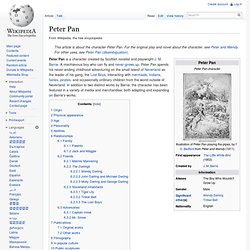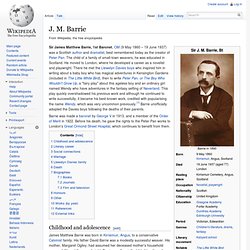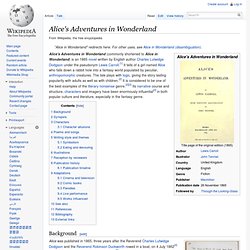

OZ Books and Authors. Spinoff's - Movies, TV, Theatre. Characters. Peter Pan. Origin[edit] Cover of 1915 edition of J.

M. Barrie's novel, first published in 1911, illustrated by F. D. Bedford. Peter Pan first appeared in a section of The Little White Bird, a 1902 novel written by J.M Barrie for adults. The character's best-known adventure first appeared on 27 December 1904, in the form of a stage play entitled Peter Pan, or The Boy Who Wouldn't Grow Up. Following the success of the 1904 play, Barrie's publishers, Hodder and Stoughton, extracted chapters 13–18 of The Little White Bird and republished them in 1906 under the title Peter Pan in Kensington Gardens, with the addition of illustrations by Arthur Rackham.[1] Physical appearance[edit] In Peter Pan in Scarlet (released internationally in 2006), Geraldine McCaughrean adds to the description of his appearance, mentioning his blue eyes, and saying his hair is light (or at least any colour lighter than black).
Age[edit] The notion of a boy who would never grow up was based on J.M. Personality[edit] Abilities[edit] J. M. Barrie. Sir James Matthew Barrie, 1st Baronet, OM (9 May 1860 – 19 June 1937) was a Scottish author and dramatist, best remembered today as the creator of Peter Pan.

The child of a family of small-town weavers, he was educated in Scotland. He moved to London, where he developed a career as a novelist and playwright. There he met the Llewelyn Davies boys who inspired him in writing about a baby boy who has magical adventures in Kensington Gardens (included in The Little White Bird), then to write Peter Pan, or The Boy Who Wouldn't Grow Up, a "fairy play" about this ageless boy and an ordinary girl named Wendy who have adventures in the fantasy setting of Neverland. This play quickly overshadowed his previous work and although he continued to write successfully, it became his best-known work, credited with popularising the name Wendy, which was very uncommon previously.[1] Barrie unofficially adopted the Davies boys following the deaths of their parents. Childhood and adolescence[edit] Alice's Adventures in Wonderland. Background[edit] Page from the original manuscript copy of Alice's Adventures Under Ground, 1864 Alice was published in 1865, three years after the Reverend Charles Lutwidge Dodgson and the Reverend Robinson Duckworth rowed in a boat, on 4 July 1862[4] (this popular date of the "golden afternoon"[5] might be a confusion or even another Alice-tale, for that particular day was cool, cloudy and rainy[6]), up the Isis with the three young daughters of Henry Liddell (the Vice-Chancellor of Oxford University and Dean of Christ Church): Lorina Charlotte Liddell (aged 13, born 1849) ("Prima" in the book's prefatory verse); Alice Pleasance Liddell (aged 10, born 1852) ("Secunda" in the prefatory verse); Edith Mary Liddell (aged 8, born 1853) ("Tertia" in the prefatory verse).[7] The journey began at Folly Bridge near Oxford and ended five miles away in the village of Godstow.

Synopsis[edit] Chapter Twelve – Alice's Evidence: Alice is then called up as a witness. Characters[edit] Symbolism[edit]